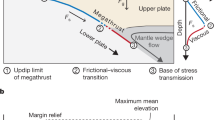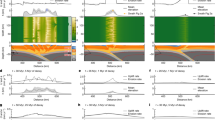Abstract
Causal links between the rise of a large mountain range and climate have often been considered to work in one direction, with significant uplift provoking climate change. Here we propose a mechanism by which Cenozoic climate change could have caused the rise of the Andes. Based on considerations of the force balance in the South American lithosphere, we suggest that the height of, and tectonics in, the Andes are strongly controlled both by shear stresses along the plate interface in the subduction zone and by buoyancy stress contrasts between the trench and highlands, and shear stresses in the subduction zone depend on the amount of subducted sediments. We propose that the dynamics of subduction and mountain-building in this region are controlled by the processes of erosion and sediment deposition, and ultimately climate. In central South America, climate-controlled sediment starvation would then cause high shear stress, focusing the plate boundary stresses that support the high Andes.
This is a preview of subscription content, access via your institution
Access options
Subscribe to this journal
Receive 51 print issues and online access
$199.00 per year
only $3.90 per issue
Buy this article
- Purchase on Springer Link
- Instant access to full article PDF
Prices may be subject to local taxes which are calculated during checkout





Similar content being viewed by others
References
Digital Elevation Model (3m × 3m) of South America (Getech, Univ. Leeds, Leeds, UK, 1998)
Muller, R. D., Roest, W. R., Royer, J.-Y., Gahagan, L. M. & Sclater, J. G. Digital isochrons of the world's ocean floor. J. Geophys. Res. 102, 3211–3214 (1997)
Cahill, T. & Isacks, B. L. Seismicity and shape of the subducted Nazca plate. J. Geophys. Res. 97, 17503–17529 (1992)
Springer, M. Heat-flow density across the Central Andean subduction zone. Tectonophysics 291, 123–139 (1998)
Lamb, S. H. Active deformation in the Bolivian Andes, South America. J. Geophys. Res. 105, 25627–25653 (2000)
National Earthquake Information Center (NEIC) Earthquake Catalogue (World Data Centre for Seismology, United States Geological Survey, Denver, 2003)
Mercier, J. L. et al. Changes in the tectonic regime above a subduction zone of Andean type: the Andes of Peru and Bolivia during the Plio-Pleistocene. J. Geophys. Res. 97, 11945–11982 (1992)
Suarez, G., Molnar, P. & Burchfiel, B. C. Seismicity, fault plane solutions, depth of faulting, and active tectonics of the Andes of Peru, Ecuador, and Southern Columbia. J. Geophys. Res. 88, 10403–10428 (1983)
Schwartz, D. Paleoseismicity and neotectonics of the Cordillera Blanca Fault Zone, Northern Peruvian Andes. J. Geophys. Res. 93, 4712–4730 (1988)
Allmendinger, R. W., Jordan, T. E., Kay, S. M. & Isacks, B. L. The evolution of the Altiplano Plateau of the Central Andes. Annu. Rev. Earth Planet. Sci. 25, 139–174 (1997)
Cembrano, J., Herve, F. & Lavenu, A. The Liquine Ofqui fault zone: a long lived intra-arc fault system in southern Chile. Tectonophysics 259, 55–66 (1996)
Cladouhos, T., Allmendinger, R., Coira, B. & Ferrar, E. Late Cenozoic deformation in the central Andes: Fault kinematics from the northern Puna, northwestern Argentina and southwestern Bolivia. J. Soc. Am. Earth Sci. 7, 209–228 (1994)
Lamb, S. H. & Hoke, L. Origin of the high plateau in the central Andes, Bolivia, South America. Tectonics 16, 623–649 (1997)
Lamb, S. H. Vertical axis rotation in the Bolivian orocline, South America, 2: Kinematic and dynamical implications. J. Geophys. Res. 106, 26605–26632 (2001b)
Molnar, P. & England, P. Temperatures, heat flux, and frictional stress near major thrust faults. J. Geophys. Res. 95, 4833–4856 (1990)
Peacock, S. in Subduction, Top to Bottom (eds Bebout, G. E. et al.) 119–133 (Geophys. Monogr. 96, American Geophysical Union, Washington, 1996)
Tichelaar, B. W. & Ruff, L. J. Depth of seismic coupling along subduction zones. J. Geophys. Res. 98, 2017–2037 (1993)
Doser, D. I. The Ancash, Peru, earthquake of 1946 November 10: evidence for low-angle normal faulting in the high Andes of northern Peru. Geophys. J. R. Astron. Soc. 91, 57–71 (1987)
Judge, A. V. & McNutt, M. Curvature and elastic plate thickness in the Peru-Chile trench. J. Geophys. Res. 96, 16,625–16,640 (1991)
Delouis, B. et al. The Andean subduction zone between 22 and 25°S (northern Chile): precise geometry and state of stress. Tectonophysics 259, 67–80 (1996)
Klotz, J. et al. GPS-derived deformation of the Central Andes including the 1995 Antofagasta Mw = 8.0 Earthquake. Pure Appl. Geophys. 154, 709–730 (1999)
Barrientos, S. E. & Ward, S. N. The 1960 Chile earthquake: inversion for slip distribution from surface deformation. Geophys. J. Int. 103, 589–598 (1990)
Angermann, D., Klotz, J. & Reigber, C. Space-geodetic estimation of the Nazca-South America Euler vector. Earth Planet. Sci. Lett. 171, 329–334 (1999)
Hyndman, R. D. & Wang, K. Thermal constraints on the zone of major thrust earthquake failure: The Cascadia Subduction Zone. J. Geophys. Res. 98, 2039–2060 (1993)
Montgomery, D. R., Balco, G. & Willet, S. D. Climate, tectonics, and the morphology of the Andes. Geology 29, 579–582 (2001)
Kulm, L. D., Schweller, W. J. & Masias, A. in Island Arcs, Deep Sea Trenches and Back-Arc Basins (eds Talwani, M. & Pitman, W. C. III) 285–301 (Maurice Ewing Ser. 1, American Geophysical Union, 1977)
Thornburg, T. & Kulm, L. D. Sedimentation in the Chile Trench: Depositional morphologies, lithofacies, and stratigraphy. Bull. Geol. Soc. Am. 98, 33–52 (1987)
Bangs, N. L. & Cande, S. C. Episodic development of a convergent margin inferred from structures and processes along the southern Chile margin. Tectonics 16, 489–503 (1997)
Giese, P., Reutter, K. J. & Scheuber, E. Welche Prozesse haben die Entstehung der extremen Dimensionen der zentralen Anden verursacht? Deformationsprozesse in den Anden 15–34 (Sonderforschungsbereich 267, Freie Univ. Berlin/Tech. Univ. Berlin/GeoForschungsZentrum Potsdam/Univ. Potsdam, Berlin, 1998)
von Huene, R. & Scholl, D. W. Observations at convergent margins concerning sediment subduction, subduction erosion, and the growth of continental crust. Rev. Geophys. 29, 279–316 (1991)
von Huene, R. & Ranero, C. R. Subduction erosion and basal friction along the sediment-starved convergent margin of Antofagasta, Chile. J. Geophys. Res. 108, 2079, doi:10.1029/2001JB001569 (2003)
Ruff, L. J. Do trench sediments affect great earthquake occurrence in subduction zones? Pure Appl. Geophys. 129, 263–282 (1989)
Gutscher, M. A. & Peacock, S. M. Thermal models of flat subduction and the rupture zone of great subduction earthquakes. J. Geophys. Res. 108(B1), 2009, doi:10.1029/2001JB000787 (2003)
Clapperton, C. Quaternary Geology and Geomorphology of South America (Elsevier, Amsterdam, 1993)
Schwertfelder, W. (ed.) Climates of Central and South America 1–532 (Elsevier, New York, 1976)
Pardo-Casas, F. & Molnar, P. Relative motion of the Nazca (Farallon) and South American plates since Late Cretaceous time. Tectonics 6, 233–248 (1987)
Somoza, R. Updated Nazca (Farallon)–South America relative motions during the last 40 My: implications for mountain building in the central Andean region. J. Soc. Am. Earth Sci. 11, 211–215 (1998)
Watts, A., Lamb, S., Fairhead, J. & Dewey, J. F. Lithospheric flexure and bending of the central Andes. Earth Planet. Sci. Lett. 134, 9–21 (1995)
Hindle, D. et al. Consistent geologic and geodetic displacements during Andean orogenesis. Geophys. Res. Lett. 29, 3757–3761 (2002)
Zachos, J., Pagani, N., Sloan, L., Thomas, E. & Billups, K. Trends, rhythms, and aberrations in the global climate 65 Ma to present. Science 292, 686–693 (2001)
Hartley, A. J. Andean uplift and climate change. J. Geol. Soc. Lond. 160, 7–10 (2003)
Strub, P. T. The Sea–Global Coastal Ocean, Regional Studies and Syntheses. (eds Robinson, A. R. & Brink, K. H.) 273–315 (Wiley, New York, 1998)
Keller, G. et al. The Cretaceous/Tertiary boundary event in Ecuador: reduced biotic effects due to the eastern boundary current setting. Mar. Micropaleontol. 31, 97–133 (1997)
Rind, D. Latitudinal temperature gradients and climate change. J. Geophys. Res. 103(D6), 5943–5971 (1998)
Gubbels, T. L., Isacks, B. L. & Farrar, E. High-level surfaces, plateau uplift, and foreland basin development, Bolivian central Andes. Geology 21, 695–698 (1993)
Lamb, S. H. Vertical axis rotation in the Bolivian orocline, South America, 1: Paleomagnetic analysis of Cretaceous and Cenozoic rocks. J. Geophys. Res. 106, 26633–26653 (2001a)
Gregory-Wodzicki, K. M. Uplift history of the Central and Northern Andes: A review. Bull. Geol. Soc. Am. 112, 1091–1105 (2000)
Lamb, S. H., Hoke, L., Kennan, L. & Dewey, J. in Orogeny Through Time (eds Burg, J.-P. & Ford, M.) 237–264 (Geol. Soc. Spec. Publ., Geological Society of London, UK, 1997)
Horton, B. K., Hampton, B. A., LaReau, B. N. & Baldellon, E. Tertiary provenance history of the northern and central Altiplano (central Andes, Bolivia): A detrital record of plateau margin tectonics. J. Sedim. Res. 72, 711–726 (2002)
Crouch, S. T. Rifts and swells: Geophysical constraints on causality. Tectonophysics 94, 23–37 (1983)
Smith, A. G. in Thrust and Nappe Tectonics (eds McClay, K. R. & Price, N. J.) 111–124 (Geol. Soc. Spec. Publ. 9, Geological Society of London, UK, 1981)
Beck, S. et al. Crustal thickness variations in the central Andes. Geology 24, 407–410 (1996)
Acknowledgements
This work was supported by grants from the European Union, Natural Environment Research Council, and Royal Society (S.H.L.) and a visiting Leverhulme professorship (P.D.).
Author information
Authors and Affiliations
Corresponding author
Ethics declarations
Competing interests
The authors declare that they have no competing financial interests.
Rights and permissions
About this article
Cite this article
Lamb, S., Davis, P. Cenozoic climate change as a possible cause for the rise of the Andes. Nature 425, 792–797 (2003). https://doi.org/10.1038/nature02049
Received:
Accepted:
Issue Date:
DOI: https://doi.org/10.1038/nature02049
This article is cited by
-
Variations in the crustal structure and strength of plate coupling along the Ryukyu subduction zone
Geoscience Letters (2023)
-
Rapid surface uplift and crustal flow in the Central Andes (southern Peru) controlled by lithospheric drip dynamics
Scientific Reports (2022)
-
Southward expanding plate coupling due to variation in sediment subduction as a cause of Andean growth
Nature Communications (2021)
-
A record of plume-induced plate rotation triggering subduction initiation
Nature Geoscience (2021)
-
Megathrust shear force controls mountain height at convergent plate margins
Nature (2020)
Comments
By submitting a comment you agree to abide by our Terms and Community Guidelines. If you find something abusive or that does not comply with our terms or guidelines please flag it as inappropriate.



